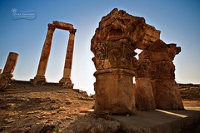
From its position on top of a hill overlooking the city, the Citadel (known locally as Jabal al-Qal'a) stands testament to the history of Amman, with its ancient ruins and excavated relics. It is the site of the ancient capital Rabbath-Ammon and numerous excavations have revealed Stone Age remains as well as those from the Roman to the Islamic periods. Other items from throughout the country are housed in the Jordan Archaeological Museum. The site contains several structures including the impressive Omayyad Palace (al-Qasr), a small Byzantine basilica and what was once the Temple of Hercules, the Great Temple of Amman. Also on the site is the Jordan Archaeological Museum, which has an excellent collection of artefacts from Jordan dating back to the earliest settlement in the region over 700,000 years ago. The Dead Sea Scrolls, Iron Age sarcophagi, and a copy of the Mesha Stele are its most important exhibits.
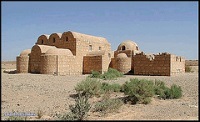
Stretching to the east of Amman towards Saudi Arabia and Iraq is the vast desert plain where a cluster of historic ruins such as castles, forts, baths, and palaces have been preserved. They are collectively known as the Desert Castles. Their purpose is largely unknown, but most are thought to have been built as recreational retreats by the Umayyad caliphs during the early Islamic Period (7th to 8th centuries AD). Qasr Mushatta is the biggest and most elaborate of the castles, a fine example of Umayyad architecture despite never being completed. The best preserved and most enchanting is the luxurious bathhouse of Qusayr Amra, with its domed ceiling, colourful interior frescoes, and mosaics. It's also a UNESCO World Heritage Site. Other desert castles include the black rock fortress at Azraq, which was the desert headquarters of Lawrence of Arabia during the Great Arab Revolt in 1917, the mysterious Qasr al-Kharrana, Qasr al-Hallabat's crumbling remains, and the well-maintained complex at Qastal.
Transport : Most of the castles can be visited on a day trip from Amman via Azraq by using a variety of public buses and minibuses combined with hitching or walking, although it is easier and less time consuming to hire a car or a taxi for the day; hotels can arrange drivers who know the way and speak English
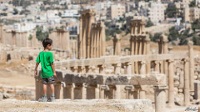
Situated about 31 miles (50km) north of Amman is one of the top attractions in Jordan: the ancient city of Jerash, considered to be one of the best-preserved Roman sites in the world. Its exceptional preservation is due to it being buried in sand for centuries and the magnificent baths, theatres, temples, arches, columns ,and stone chariot-rutted streets have long attracted scholars and tourists from across the world to admire the most complete city in the Roman Decapolis. Excavations dating to the Neolithic Age have indicated that Jerash was continuously occupied for more than 6,500 years. Today visitors can marvel as the ancient amphitheatre comes to life at the annual Jerash Festival of Culture and Arts, where artists from around the globe sing, dance, act, and play music on stage in a celebration of Jordanian and international culture.
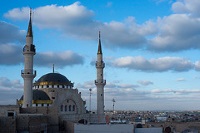
Madaba is most famous for its spectacular Byzantine and Umayyad mosaics from the 5th to 7th centuries which are scattered throughout the town's homes and churches. Located just 19 miles (30km) south of Amman, Madaba is also home to the famous 6th-century mosaic map of the Holy Land, in which Jerusalem and its surrounding regions are depicted. One of the town's most beautiful mosaics covers the floor of the Byzantine Church of the Apostles, and the Archaeological Park features an impressive collection of mosaic collages, where a series of ramps has been built over excavated mosaics to allow people to view them from above. The Greek Orthodox Church of St George is home to Madaba's main attraction and most famous mosaic: the 6th-century Madaba Map. Millions of pieces of coloured stone embedded on the church floor create a vivid picture of Jerusalem and its holy sites, including the Church of the Holy Sepulchre, the Dead Sea, Jericho, and the Jordan River. It is the earliest surviving original map of the region and was laid around 560 AD. Madaba is also known for its hand-woven carpets and tapestries and it is possible to see them being made in several shops around town.
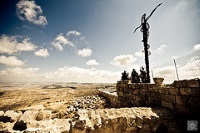
The most sacred site in Jordan, Mount Nebo is believed to be the burial site of Moses who climbed the hill in order to survey the Promised Land that he would never enter. Situated on the edge of a plateau about six miles (10km) from Madaba, Mount Nebo affords spectacular views towards Jerusalem, whose spires are visible on a clear day, and across the Jordan Valley and the Dead Sea. A modern day shrine sits on the ruins of a 6th-century Byzantine monastery, and affords protection to the original floor mosaics, while in the grounds stands the symbolic Serpentine Cross.
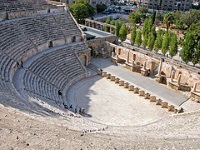
Below the Citadel is the magnificent Roman amphitheatre, an impressive relic from ancient Philadelphia that is cut into the hill and can seat up to 6,000 people. The theatre is still used occasionally for events today. Two cultural museums form part of the complex: the Jordan Folklore Museum, which has exhibits on traditional life, and the Museum of Popular Traditions with traditional costumes and mosaics from 4th to 6th century Jordanian churches. The theatre was built during the reign of Antonius Pius (138-161 CE) and is today a famous landmark in Amman and of course the ancient Roman city Philadelphia. It surrounds the Hashemite Plaza, Odeon Theatre, and the Nymphaeum.
Address : Quraysh Street, Downtown
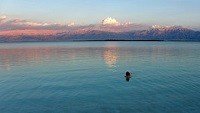
Situated about 28 miles (45km) from Amman, lies the famous attraction of the Dead Sea, the lowest point on earth at 1,335 feet (407m) below sea level. Devoid of plant or animal life due to the high salt concentration (four times saltier than normal), it is the incredible mineral rich water that has made it an internationally sought-after destination since ancient times, popular for its curative properties as well as for the experience of floating effortlessly on its surface. Most holidaymakers go to the main resort area on the northern shore at Sweimeh, where the Government Rest House provides showers, a restaurant, a beach, and the opportunity to smother oneself in the mineral-rich black mud. Accommodation is available at the Dead Sea Spa Hotel, where various medical treatments are also on offer.
Transport : Buses leave from Muhajrin station to the Government Rest House at Sweimeh.

Travel Guide powered by Word Travels, copyright © 2023 Globe Media Ltd. By its very nature information in this travel guide is subject to change at short notice and travellers are urged to verify information on which they're relying with the relevant authorities. Neither Globe Media Ltd nor Travel Vogue can accept any responsibility for any loss or inconvenience to any person as a result of information contained above.